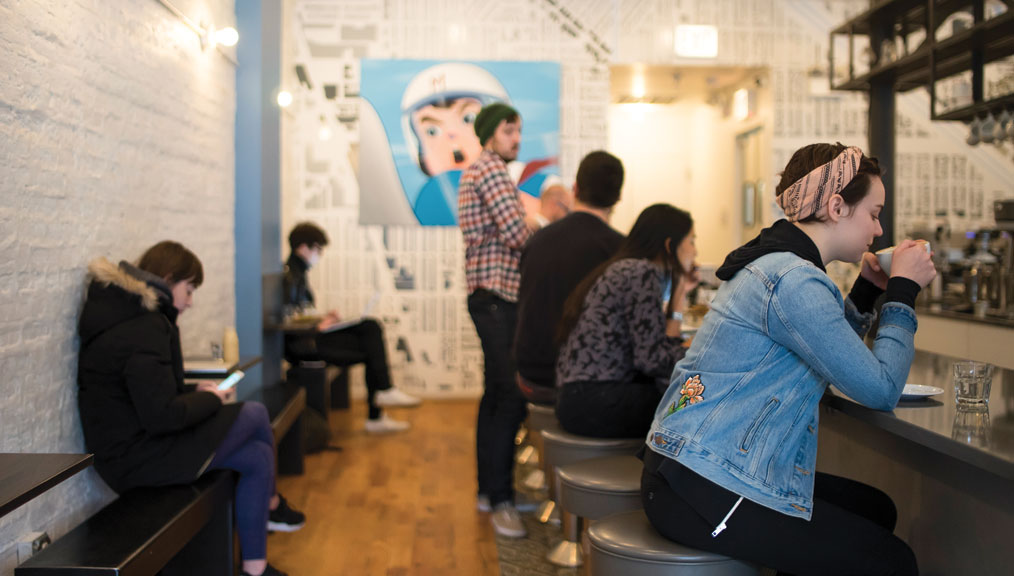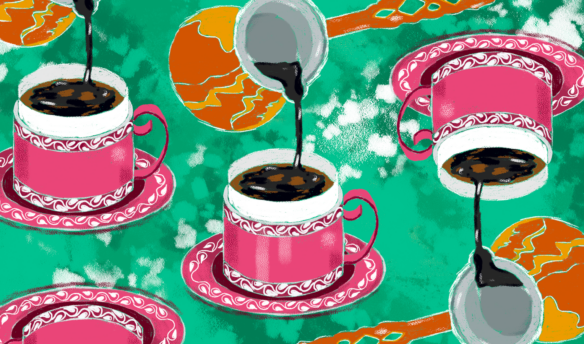[V]isit practically any American coffee shop, be it third-wave or international chain, and you probably already know how to order. You’ll file into a line and slowly shuffle your way up to the cash register where you’ll inform the barista of your desired drink, exchange money, and try to find an inconspicuous place to stand while you wait. If you’re lucky, the barista might call for you by name rather than simply shouting out your drink when it’s ready for you to pick up at the counter.
Being well versed in coffee-ordering protocol, I had a certain set of expectations in mind as I popped into Intelligentsia’s Logan Square café in Chicago, Illinois, for the first time on a busy Sunday morning. I had been to several other Intelligentsia locations, so I didn’t anticipate anything out of the ordinary. But when I found my place at the back of the queue, an unexpected thing happened.
“If you’re staying here, we can take your order at the bar,” said a barista. A warm timbre and confident eye contact assured me this was normal here.
I spotted the last empty seat in the row of bar stools lining both sides of the U-shaped counter. As I squeezed in next to some marketing graduate students working on a class project, another barista met me with a glass of water and a menu. I ordered a shot of espresso and opted to start a tab.
As I sat at the bar and took a sip of my chocolaty-sweet Black Cat espresso, I was reminded of another Chicago icon: Edward Hopper’s painting, Nighthhawks, which hangs across town in the Art Institute of Chicago. The painting depicts a similar bar scene at an all-night diner where customers have congregated around the counter as a bartender serves them mugs of black coffee. Whether the parallels were intentional, the thought made me feel a sense of connectedness to the city.
Before I left the café, I had my water glass refilled multiple times, picked up a bag of whole bean coffee, and had a nice conversation with a barista about other Chicago coffee shops worth visiting, all without having to get back in line.
Although I had numerous good cups of coffee around the city, that experience stuck with me long after my weekend in Chicago.
“There’s always room to reimagine service,” says Andrew Atkinson, Intelligentsia’s regional retail manager of new markets. “Especially in the coffee industry.”
For Intelligentsia Logan Square, that inspiration comes from the proliferation of all-night diners around the city in the thirties and forties. Although there is still a queue for customers who want to grab their coffee and go, dine-in customers at Logan Square enjoy full service at the bar. “Everything is taken care of for you,” Atkinson says. “Just sit down at the counter.”
The flexibility of the service model is surprising when compared to a more conventional model of queueing at a register. Although new technologies and perspectives have revolutionized how coffee is sourced, roasted, and brewed, the service models utilized by coffee shops have gone largely unexamined. Specialty coffee’s value proposition is based on a superior product, but the industry at large has uncritically inherited a fast food service model.
“If a customer is paying seven dollars for a cup of coffee, they don’t want to have a fast food experience,” Atkinson says.
A 360-Degree Perspective
Perhaps the most prominent rejection of queue-style service is found at G&B Coffee in Los Angeles, California. The much-celebrated walk-up coffee bar in downtown’s Grand Central Market features a 360-degree bar around which customers can order from any point. The shop employs a self-dubbed “zone defense” approach to customer service. Up to six baristas take orders around the bar, close out checks, and deliver drinks to customers. If a line starts to form, guests are politely asked to step up to the bar.
For company cofounders Charles Babinski and Kyle Glanville, the service model is based on a simple mantra. “Serve customers where they are,” Babinski says. “Remove all the barriers to service.”
The inspiration for the bar-style service came during a trip to Spain for a friend’s wedding. With a few extra days to explore Madrid, the pair discovered a love for the neighborhood shops selling bocadillos, a traditional cured ham sandwich. In these shops customers are served and eat their bocadillo at the counter, side by side with the other patrons. Babinski and Glanville were struck by the intimate, communal feel of the service. After returning to California they knew they wanted to capture “the feeling of being in a place where everybody is rubbing shoulders.”
But providing intimate service was only one of their goals. They also had a more practical concern: how to serve as many cups of coffee as possible. Grand Central Market attracts tens of thousands of visitors a day. They knew they had to be able to serve a high volume of customers without sacrificing quality. By moving away from a linear service model, Glanville and Babinski found they were free to explore more efficient systems.
“At G&B we have up to six POS [points-of-sale] going at once. Some of our busiest hours we’ve ever had did not look that busy from the outside,” Babinski says. “You could convert that to a line and it would be thirty or forty people deep.”
But Babinski is adamant bar-style service is not a panacea of service models. In fact, he discourages most cafés from trying it. “Our model is not a model that’s going to sweep the nation,” Babinski says. “It’s hard to execute without people who are committed to it. When the wheels come off, it’s terrible.” And yet, for G&B, the benefits outweigh the costs. “It’s way harder. It’s way more work,” Babinski says. “But the rewards are meaningful.”
He credits the bar-style service as not only improving hospitality and efficiency, but also creating a livelier café environment. Rather than customers waiting in line staring at their phones, they are standing side by side at the bar. Regulars are more likely to strike up a conversation with each other and less likely to become impatient waiting for a drink.
Portability of Service
Although few American coffee shops are offering full bar service, a growing number of cafés are enlisting mobile point-of-sale technology to offer a hybrid approach. One such café is Blueprint Coffee in St. Louis, Missouri.
“In the design of the café, one of the main components is the portability of service,” says Kevin Reddy, Blueprint cofounder and director of retail operations. “We could take care of someone at their table, or, if they had a dog, outside. Any conversation can effectively turn into a point of sale.” For Reddy and the rest of the staff at Blueprint, this model of service adds a human touch. “The focus of what we’re doing is not a cash register,” Reddy says.
Meeting customers where they are is just one element of Blueprint’s hospitality culture.
“So many people are used to customer service only lasting until they make the drink,” Reddy says. “We bring every drink out to the table. We don’t have a bus tub.”
For Reddy, the more labor-intensive service model comes part and parcel with a focus on coffee quality. “That level of service speaks to the ethos behind what we do,” he says. “And shows them that we care.”
An important component of Blueprint’s service model is a system of color-coded coasters that accompany each beverage. Each color corresponds with a different coffee, which allows a barista working the café floor to automatically know what a guest is drinking. This empowers baristas checking in on a customer to ask how the coffee was and whether they would like another cup. Baristas are also trained to meet new customers where they are and help guide them through the café experience.
“You can always tell if it’s somebody’s first time in. There’s not an ‘Order Here’ sign or a ‘Pick-up Here’ sign. They want to follow those normal patterns,” Reddy says. He notes that customers’ uncertainty in the absence of signs and queues opens the door for interaction. “People walk up to the brew bar; we’re forced to address them immediately and help them through their experience.”
Questioning New Service Models
Non-linear service models might be challenging the status quo in retail coffee, but they also raise the question: do customers actually want new service models?
At Blueprint, Reddy admits that in peak hours customers naturally form a line, and they don’t discourage them from doing so. “It’s natural for people to queue up,” he says. “It’s during the slower times we’re freer to take advantage of the mobility of our plan.”
Reddy’s observation leads other specialty coffee professionals to question whether departing from the conventional paradigm is necessary.
Ryan Soeder, director of training at Louisville’s Sunergos Coffee, advocates for a conventional linear service model. “It’s not that it’s broken. It isn’t,” Soeder says. “It’s the only thing we can do right now. You only make money by serving as many three-dollar cups of coffee as you can. Any other model requires staffing that is nearly impossible to pull off.”
Soeder, whose resume includes Intelligentsia and Counter Culture Coffee, thinks often about workflow, as demonstrated by the same word tattooed across his knuckles.
“Most coffee shops don’t have anyone in charge of tuning their workflow,” says Soeder, who advises cafés to critically evaluate their bar flow systems.
He urges café managers to establish workflow priorities. This entails a fully articulated workflow guide, so each barista knows their exact responsibilities on bar. Whether it’s taking orders, prepping espresso beverages, or brewing coffee, a clear division of labor will maximize efficiency and help ensure quality. “I think the underlying theme would be intentionality,” Soeder says. “Know what you’re about, then support that.”
Although Soeder is intrigued by the possibilities models like G&B’s create, he questions their repeatability. “If you tried to do that in Louisville it would probably freak people out,” he says.
Babinski wouldn’t necessarily disagree with Soeder. For him, the most important thing is not whether a café uses bar service, table service, or a more conventional queue.
“Just remove the impediments to employees serving the customer,” Babinski says. “Give them the power.”
—Michael Butterworth is the founding editor of the Coffee Compass.





















